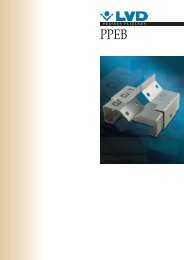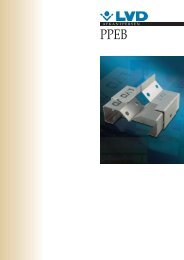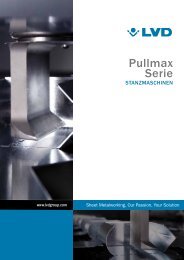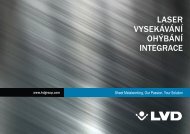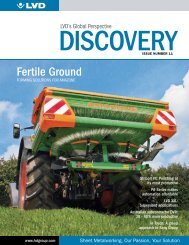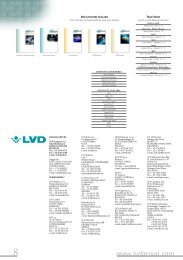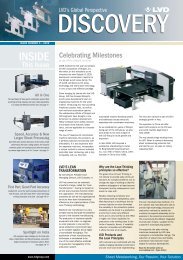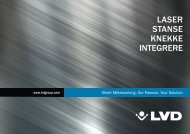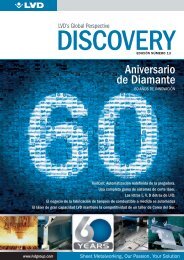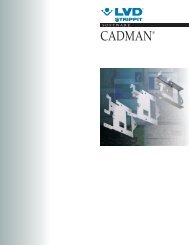Discovery Newsletter 11 - English International - LVD
Discovery Newsletter 11 - English International - LVD
Discovery Newsletter 11 - English International - LVD
You also want an ePaper? Increase the reach of your titles
YUMPU automatically turns print PDFs into web optimized ePapers that Google loves.
Accurate Forming of<br />
Crane Booms<br />
The KSK plant at Schwerte, part of the Vlassenroot<br />
group, has expanded its capacity for the production<br />
of mobile crane booms with the installation of a<br />
new <strong>LVD</strong> PPEB-H 2000T 14m press brake.<br />
Vlassenroot is one of the world’s major<br />
manufacturers of critical components for<br />
mobile cranes and operates across four sites<br />
in Belgium, Germany and Poland. One of the<br />
strengths of the group is that it has all of its<br />
production processes in-house and can offer<br />
crane manufacturers a complete fully welded<br />
boom and chassis from one supplier.<br />
In fact, the acquisition of KSK in 1999, which<br />
had extensive welding facilities, was driven<br />
by the demand from crane manufacturers for<br />
complete welded booms.<br />
“We have complete control of the whole<br />
process, from steel to welded boom section,<br />
and we are the only one in the world that can<br />
offer that,” says Ludwig Deckers, plant manager<br />
at Schwerte. “That gives us a lot of advantages<br />
and it gives the crane manufacturers a lot of<br />
advantages too.”<br />
He adds that in recent years the strongest part<br />
of the market has been in cranes for the wind<br />
power sector, which puts Vlassenroot at an<br />
advantage because its <strong>LVD</strong> press brakes give<br />
it the large-scale production capability to meet<br />
this demand.<br />
“The largest crane we build parts for has a 500T<br />
capacity and the longest section we produce at<br />
Schwerte is 14,55m long. We supply all leading<br />
crane companies throughout the world.<br />
Herr Deckers explains that the partnership with<br />
<strong>LVD</strong> goes back a number of years.<br />
“Our first link with <strong>LVD</strong> came when we asked<br />
them to rebuild one of these as a CNC machine<br />
with new hydraulics and controls. It all went<br />
exceptionally smoothly so we asked them to<br />
rebuild all our press brakes. So when<br />
we needed new capacity in Belgium it was<br />
a natural step for us to go to them for new<br />
machines too. We now have two 2000T <strong>LVD</strong><br />
PPEB 14m press brakes at our Belgian plant.<br />
“We went to <strong>LVD</strong> for this new machine too<br />
because of the good experience we’d had with<br />
them and the service they provide.”<br />
The new machines <strong>LVD</strong> built for Vlassenroot<br />
– and now KSK – were designed specifically to<br />
be the optimum configuration for crane boom<br />
forming in high strength steels.<br />
The latest machine includes a couple of further<br />
refinements. The first is a series of CNC pushers<br />
at the front of the machine that ensure the plate<br />
is firmly located on the back gauges.<br />
“It was a hell of a job for the operators to push<br />
these long and heavy components up against the<br />
back gauges, so we asked <strong>LVD</strong> to come up with<br />
an automatic system rather than using manpower.<br />
It has worked very well,” says Herr Deckers.<br />
The second special feature is a bottom die that<br />
can be adjusted in 10mm increments from<br />
<strong>11</strong>0mm up to 320mm. This is to allow KSK to<br />
cope with some of the very large bend<br />
radii required on the higher strength steels.<br />
Bending these materials requires special<br />
expertise and the highest quality equipment<br />
says Mr. Deckers.<br />
“In normal steel, to bend an angle of 90 degrees<br />
you may have to bend to 89 or 88 degrees to<br />
allow for springback. With the <strong>11</strong>00 Newton<br />
tensile strength material we commonly bend you<br />
may have a springback of 30 degrees – so you<br />
have to bend to 60 degrees. So you need a lot<br />
of force to go into the die to bend the material.”<br />
The stronger the material, the lighter and taller<br />
the crane builders can make their telescopic<br />
booms. There is currently talk of 1300 Newton<br />
or even 1600 Newton tensile strength steel in<br />
the future – but that would require designs and<br />
welding materials that have yet to be developed.<br />
“The bend accuracy is crucially important to us<br />
because of the requirements of the end product.<br />
Although we are making very large components<br />
– up to more than 14m long – the tolerances<br />
the customers are asking for are very tight. On<br />
a boom section 1,6m in diameter, the height<br />
and the width have to be within plus or minus<br />
2mm on the welded fabrication. Otherwise, the<br />
telescopic boom sections won’t slide in and out<br />
properly,” says Herr Deckers.<br />
“After only a few weeks of operating the<br />
new machine it has proved itself to be more<br />
accurate and more productive than the machine<br />
we had before. I didn’t expect such positive<br />
results so quickly.”<br />
“The bend accuracy<br />
is crucially important<br />
to us because of the<br />
requirements of the<br />
end product.”<br />
Herr Deckers<br />
To read the full version of this article,<br />
visit www.lvdgroup.com.



